课程名称 生物专业英语
- 格式:doc
- 大小:87.00 KB
- 文档页数:7
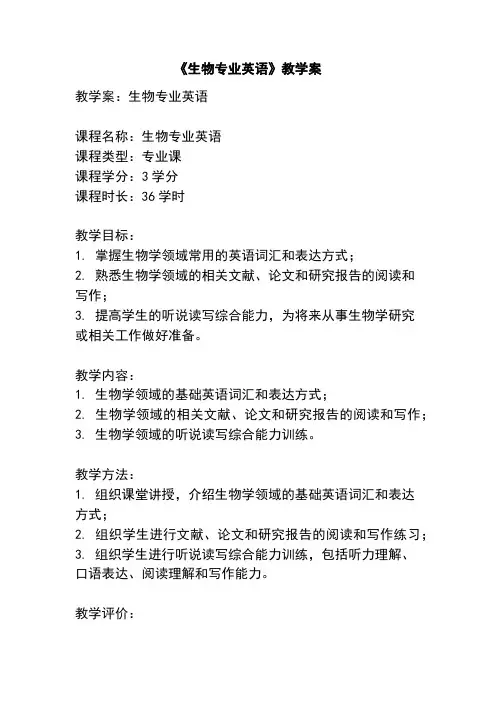
《生物专业英语》教学案教学案:生物专业英语课程名称:生物专业英语课程类型:专业课课程学分:3学分课程时长:36学时教学目标:1. 掌握生物学领域常用的英语词汇和表达方式;2. 熟悉生物学领域的相关文献、论文和研究报告的阅读和写作;3. 提高学生的听说读写综合能力,为将来从事生物学研究或相关工作做好准备。
教学内容:1. 生物学领域的基础英语词汇和表达方式;2. 生物学领域的相关文献、论文和研究报告的阅读和写作;3. 生物学领域的听说读写综合能力训练。
教学方法:1. 组织课堂讲授,介绍生物学领域的基础英语词汇和表达方式;2. 组织学生进行文献、论文和研究报告的阅读和写作练习;3. 组织学生进行听说读写综合能力训练,包括听力理解、口语表达、阅读理解和写作能力。
教学评价:1. 平时成绩占总评成绩的50%,包括课堂表现、作业完成情况等;2. 期末考试占总评成绩的50%,包括听力、口语、阅读和写作等方面的考核。
教学安排:第一周:介绍课程内容和教学目标,进行生物学领域的基础英语词汇和表达方式的讲解。
第二周:组织学生进行生物学领域文献、论文和研究报告的阅读练习,要求学生掌握阅读技巧和理解能力。
第三周:进行生物学领域听力训练,包括听取生物学相关讲座、演讲和讨论,并进行口语表达练习。
第四周:组织学生进行生物学领域的写作练习,包括摘要、实验报告和论文等的写作。
第五周:进行生物学领域的阅读理解练习,包括阅读和理解生物学相关文献和研究报告。
第六周:进行生物学领域的综合能力训练,包括听说读写的综合练习和模拟考试。
第七周:进行期末考试,包括听力、口语、阅读和写作等方面的考核。
第八周:总结课程内容和教学效果,进行学生评价和教师评价。
教学资源:1. 生物学领域的教材和参考书籍;2. 生物学领域的相关文献、论文和研究报告;3. 生物学领域的讲座、演讲和讨论录音或视频资料;4. 生物学领域的写作指南和范例;5. 听力、口语、阅读和写作练习题目和模拟试卷。
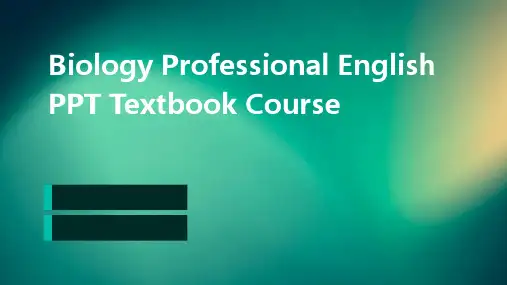
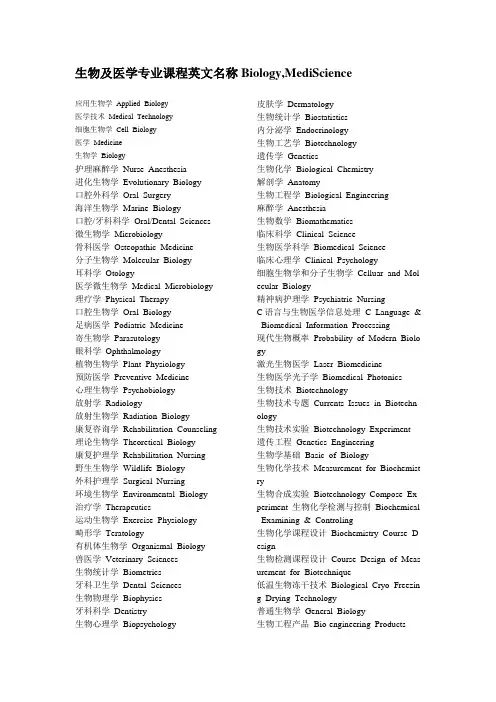
生物及医学专业课程英文名称Biology,MediScience应用生物学Applied Biology医学技术Medical Technology细胞生物学Cell Biology医学Medicine生物学Biology护理麻醉学Nurse Anesthesia进化生物学Evolutionary Biology口腔外科学Oral Surgery海洋生物学Marine Biology口腔/牙科科学Oral/Dental Sciences 微生物学Microbiology骨科医学Osteopathic Medicine分子生物学Molecular Biology耳科学Otology医学微生物学Medical Microbiology 理疗学Physical Therapy口腔生物学Oral Biology足病医学Podiatric Medicine寄生物学Parasutology眼科学Ophthalmology植物生物学Plant Physiology预防医学Preventive Medicine心理生物学Psychobiology放射学Radiology放射生物学Radiation Biology康复咨询学Rehabilitation Counseling 理论生物学Theoretical Biology康复护理学Rehabilitation Nursing野生生物学Wildlife Biology外科护理学Surgical Nursing环境生物学Environmental Biology 治疗学Therapeutics运动生物学Exercise Physiology畸形学Teratology有机体生物学Organismal Biology兽医学Veterinary Sciences生物统计学Biometrics牙科卫生学Dental Sciences生物物理学Biophysics牙科科学Dentistry生物心理学Biopsychology 皮肤学Dermatology生物统计学Biostatistics内分泌学Endocrinology生物工艺学Biotechnology遗传学Genetics生物化学Biological Chemistry解剖学Anatomy生物工程学Biological Engineering麻醉学Anesthesia生物数学Biomathematics临床科学Clinical Science生物医学科学Biomedical Science临床心理学Clinical Psychology细胞生物学和分子生物学Celluar and Mol ecular Biology精神病护理学Psychiatric NursingC语言与生物医学信息处理C Language & Biomedical Information Processing现代生物概率Probability of Modern Biolo gy激光生物医学Laser Biomedicine生物医学光子学Biomedical Photonics生物技术Biotechnology生物技术专题Currents Issues in Biotechn ology生物技术实验Biotechnology Experiment 遗传工程Genetics Engineering生物学基础Basic of Biology生物化学技术Measurement for Biochemist ry生物合成实验Biotechnology Compose Ex periment 生物化学检测与控制Biochemical Examining & Controling生物化学课程设计Biochemistry Course D esign生物检测课程设计Course Design of Meas urement for Biotechnique低温生物冻干技术Biological Cryo Freezin g Drying Technology普通生物学General Biology生物工程产品Bio-engineering Products生物工程导论Introduction to Bio-engineeri ng生物化学Biochemistry生物化学工程Biochemical Engineering生物化学及实验Biochemistry Experiment 生物检测技术Measurement for Biotechniq ue生物控制论Biocybernetics 生物流变学Biorheology生物物理Biophysics生物学专题Currents Issues in Biology 生物医学超声学Biomedical Supersonics 细胞生物学Cell Biology。
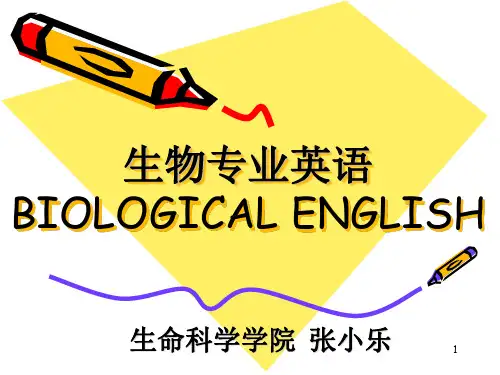
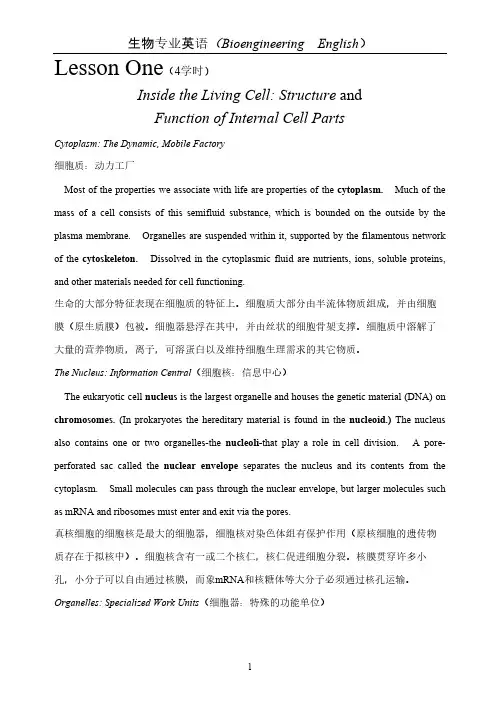
All eukaryotic cells contain most of the various kinds of organelles, and each organelle performs a specialized function in the cell. Organelles described in this section include ribosomes, the endoplasmic reticulum, the Golgi complex, vacuoles, lysosomes, mitochondria, and the plastids of plant cells.所有的真核细胞都含有多种细胞器,每个细胞器都有其特定功能。
本节主要介绍核糖体,内质网,高尔基体系,液泡,溶酶体,线粒体和植物细胞中的质体。
The number of ribosomes within a cell may range from a few hundred to many thousands. This quantity reflects the fact that, ribosomes are the sites at which amino acids are assembled into proteins for export or for use in cell processes. A complete ribosome is composed of one larger and one smaller subunit. During protein synthesis the two subunits move along a strand of mRNA, "reading" the genetic sequence coded in it and translating that sequence into protein. Several ribosomes may become attached to a single mRNA strand; such a combination is called a polysome. Most cellular proteins are manufactured on ribosomes in the cytoplasm. Exportable proteins and membrane proteins are usually made in association with the endoplasmic reticulum.核糖体的数量变化从几百到几千,核糖体是氨基酸组装成蛋白质的重要场所。
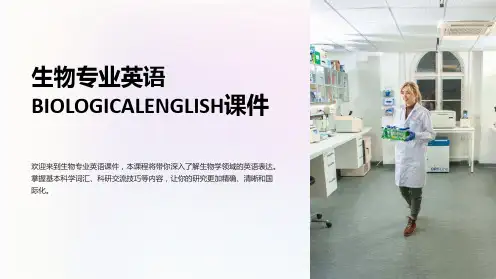
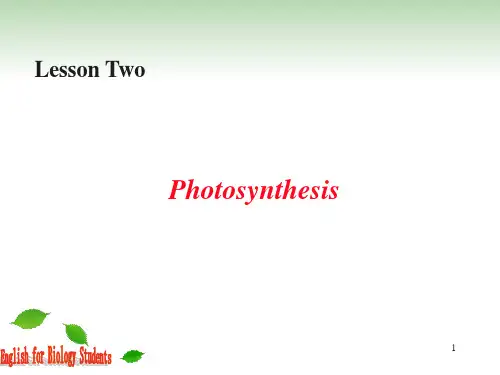
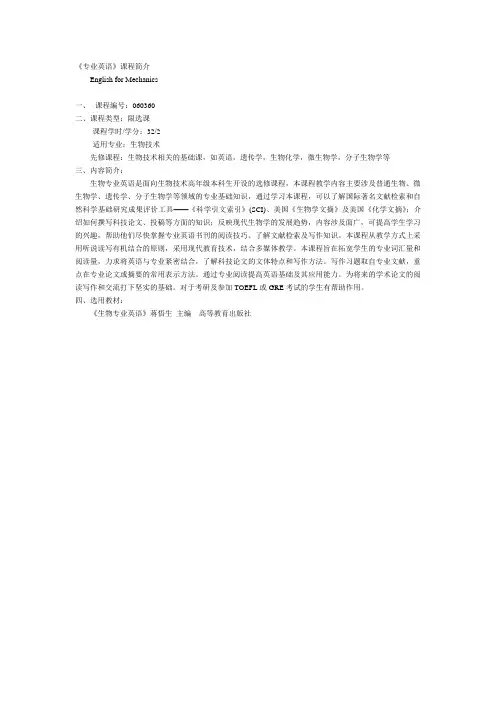
《专业英语》课程简介English for Mechanics一、课程编号:060360二、课程类型:限选课课程学时/学分:32/2适用专业:生物技术先修课程:生物技术相关的基础课,如英语,遗传学,生物化学,微生物学,分子生物学等三、内容简介:生物专业英语是面向生物技术高年级本科生开设的选修课程,本课程教学内容主要涉及普通生物、微生物学、遗传学、分子生物学等领域的专业基础知识,通过学习本课程,可以了解国际著名文献检索和自然科学基础研究成果评价工具——《科学引文索引》(SCI)、美国《生物学文摘》及美国《化学文摘》;介绍如何撰写科技论文、投稿等方面的知识;反映现代生物学的发展趋势,内容涉及面广,可提高学生学习的兴趣,帮助他们尽快掌握专业英语书刊的阅读技巧、了解文献检索及写作知识。
本课程从教学方式上采用听说读写有机结合的原则,采用现代教育技术,结合多媒体教学。
本课程旨在拓宽学生的专业词汇量和阅读量,力求将英语与专业紧密结合,了解科技论文的文体特点和写作方法。
写作习题取自专业文献,重点在专业论文或摘要的常用表示方法。
通过专业阅读提高英语基础及其应用能力。
为将来的学术论文的阅读写作和交流打下坚实的基础。
对于考研及参加TOEFL或GRE考试的学生有帮助作用。
四、选用教材:《生物专业英语》蒋悟生主编高等教育出版社《专业英语》课程教学大纲二、课程编号:060360二、课程类型:限选课课程学时:32适用专业:生物技术先修课程:生物技术相关的基础课,如英语,遗传学,生物化学,微生物学,分子生物学等。
三、课程性质与任务:生物专业英语是生物技术专业的限选课,通过学习本课程,可以了解国际著名文献检索和自然科学基础研究成果评价工具——《科学引文索引》(SCI)、美国《生物学文摘》及美国《化学文摘》;介绍如何撰写科技论文、投稿等方面的知识;反映现代生物学的发展趋势,内容涉及面广,可提高学生学习的兴趣,帮助他们尽快掌握专业英语书刊的阅读技巧、了解文献检索及写作知识。
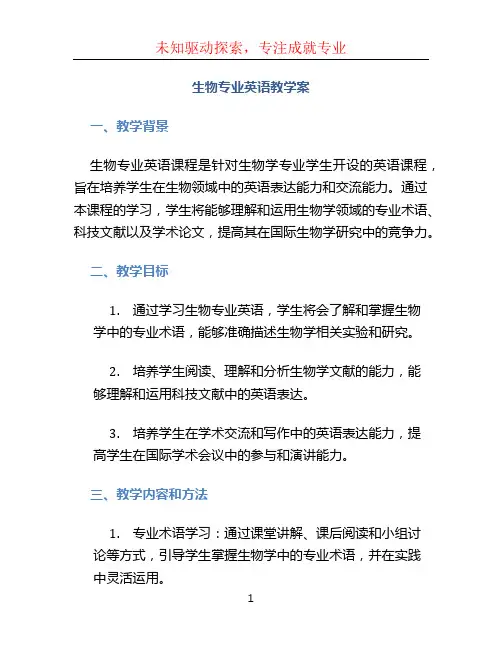
生物专业英语教学案一、教学背景生物专业英语课程是针对生物学专业学生开设的英语课程,旨在培养学生在生物领域中的英语表达能力和交流能力。
通过本课程的学习,学生将能够理解和运用生物学领域的专业术语、科技文献以及学术论文,提高其在国际生物学研究中的竞争力。
二、教学目标1.通过学习生物专业英语,学生将会了解和掌握生物学中的专业术语,能够准确描述生物学相关实验和研究。
2.培养学生阅读、理解和分析生物学文献的能力,能够理解和运用科技文献中的英语表达。
3.培养学生在学术交流和写作中的英语表达能力,提高学生在国际学术会议中的参与和演讲能力。
三、教学内容和方法1.专业术语学习:通过课堂讲解、课后阅读和小组讨论等方式,引导学生掌握生物学中的专业术语,并在实践中灵活运用。
2.科技文献阅读:通过分析和讨论科技文献,培养学生理解和分析生物学文献的能力,并通过写作和口头报告展示研究成果。
3.学术写作训练:通过给学生布置论文写作和报告写作任务,培养学生在学术写作中的英语表达能力,包括提纲撰写、引言撰写、方法和结果的描述等。
4.学术交流训练:通过模拟学术会议和小组讨论,培养学生学术交流和演讲的英语表达能力,加强学生的学术素养和自信心。
四、教学评价方法1.参与度评价:考察学生在课堂上的主动参与度、提问和讨论的积极性,通过课堂讨论、小组讨论和问答等形式进行评价。
2.作业评价:评估学生的作业完成情况,包括课后阅读、科技文献分析和论文写作等任务的完成情况和质量。
3.课堂测试评价:通过课堂测试考察学生对于专业术语的掌握程度和对科技文献的理解程度。
4.学术交流评价:通过模拟学术会议和小组讨论的方式进行评价,考察学生在学术交流和演讲中的英语表达能力。
五、教学资源和参考资料1.《生物学英语教程》(第二版),作者:杨春燕,出版社:清华大学出版社,年份:2018年。
2.《英语科技文献写作与翻译》(第二版),作者:王翠春,出版社:高等教育出版社,年份:2019年。
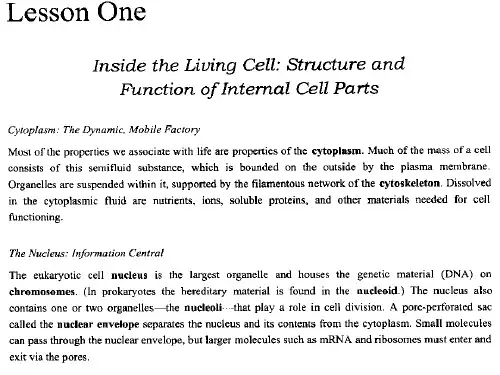
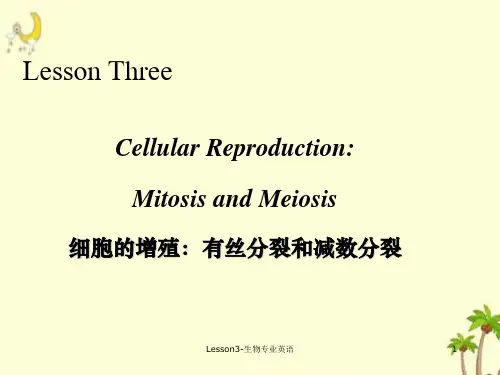
课程名称生物专业英语英文名称Special English for Biology【课程编号】【课程类别】专业选修课【学分数】【适用专业】生物科学【学时数】34 【编写日期】2013.7.31一、教学目标生物专业英语是面向生物科学、技术高年级本科生开设的限选课程,本课程教学内容主要涉及普通生物、微生物学、遗传学、分子生物学等领域的专业基础知识。
通过本课程,向学生介绍如何撰写科技论文、投稿等方面的知识;扩大专业英语的词汇量,掌握专业英语书刊的阅读技巧、了解文献检索及写作知识。
二、教学内容和学时分配Lesson One Inside the living cell:structure and function of internal cell parts 4学时主要内容:1.GlossaryActin, centriole, chemotaxis, chloroplast, chromosome, cilia, cytoplasm, cytoskeleton, dynein, flagella, lysosome, microfilament, microtubule, mitochondrion, myosin, nucleoid, nucleoli, nucleus, phagocytosis, pinocytosis, plastid, polysome, ribosome, stroma, tubulin, vacuole,endoplasmic reticulum, nuclear envelope, golgi complex, basal body2.重点句型分析分析(1)This quantity reflects the fact that ribosomes are the sits at which ammo acids are assembled into proteins for export or for use in cell processes.(2)During protein synthesis the two subunits move along a strand of mRNA, ”reading” the genetic sequence coded in it and translating that sequence into protein.(3)Both types of endoplasmic reticulum serve as compartments within the cell where specific products can be isolated and subsequently shunted to particular areas in or outside the cell.(4)A subset of vacuoles is the organelles known as lysosomes, which contain digestive enzymes(packaged in lysosomes in the golgi complex)that can break down most biological macromolecules.(5)It is on the large surface area provided by the inner cristae of mitochondria that ATP-generatating enzymes are located.3.Exercises4.Symbols Commonly Used教学要求:使学生掌握细胞的组成结构(各种细胞器以及它们在细胞中的位置),以及结构与功能之间的关系。
《生物专业英语》教学大纲课程编码:090108\090966英文名称:Specialized English in Biology—、基本信息1.学分与学时学分:2,学时:322.课程类别专姙修俯呈3.适应专业生物科学专业、生物技术专业,选修4.课程目的(1)生物专业英语是面向生物科学、生物技术高年级木科生开设的限选课稈,木课稈教学内容主要涉及普通生物、微生物学、遗传学、分了生物学等领域的专业基础知识。
通过木课程,向学生介绍如何撰写科技论文、投稿等方面的知识;扩大专业英语的词汇最,掌握专业英语书刊的阅读技巧、了解文献检索及写作知识。
(2)木课稈帮助已有一定英语基础的学生提高其阅读、翻译专业英语的能力。
旨在拓宽学生的专业词汇量和阅读量,力求将英语与专业紧密结合,了解科技论文的文体特点和写作方法,为将来的学术论文的阅读写作和交流打下坚实的基础。
5.建议先修课程大学英语6.教学方法与手段(1)木课程采用自学与讲授相结合,理论与实践相结合的教学方法。
教学中突出以学生作为主体,运用多媒体等教学手段对其进行专业英语的学习指导。
(宋体五号)(2)同时为了提高学生英语听说读写的基础能力,可采取小组讨论式等灵活多样的教学形式,调动其学习积极性。
7.考核及成绩评定考核方式:木课程为考查课,期末开卷考试。
成绩评定:(1)平时成绩占20%,形式有:课堂讨论、课外作业、学生考勤、课堂提问、听课状态(2)结课考试成绩占80%,形式有:笔试8.课外自学要求(1)学生能够按照要求按时完成作业,积极参加课后辅导答疑。
(2)勤于浏览屮国知网,杳询学科前沿知识,能够利用所学理论设计实验,达到应用型人才培养的标准。
(3)能够利用数字课稈网站和精品课稈网站进行H主学习和课后复习。
9.推荐教材和主要参考书目推荐教材:生物专业英语(第二版)•蒋悟生主编.高等教育出版社.2000年.参考书目:[1]生物工程、生物技术专业英语(第一版)•乌1(行彦等编.化学工业出版社.2002年. ⑵科技英语的特点和应用(笫一版).戴炜华、陈文雄编.上海外语教育出版社・1984年.二、主要教学内容和教学要求第一章Lesson one Introduce基本内容:一、生物专业英语的概念。
生物专业英语课程简介《生物技术专业英语》课程教学大纲一、课程基本信息课程名称:生物技术专业英语课程英文名称:Biotechnology English / Readings in English for biotechnology students课程学时:32先修课程:大学英语,普通生物学,生物化学,微生物学,分子生物学等。
二、课程性质与目的专业英语是面向生物技术专业本科生开设的选修课程,旨在使学生熟悉并掌握生物技术专业词汇、专业用语,熟悉专业外文书刊常见的长句和复杂句等句型及专业知识的特殊表达方法,掌握英汉互译技巧,使学生具备能读能写专业方面的英文资料的初步能力。
为学生顺利阅读和正确理解生物专业英语书刊,尤其是现代生物学书刊,打下坚实基础。
本课程教学内容主要涉及普通生物、微生物学、遗传学、分子生物学等领域的专业基础知识,内容涉及面广,可提高学生学习的兴趣,帮助他们尽快掌握专业英语书刊的阅读技巧、了解文献检索及写作知识。
二、课程教学内容介绍专业英语与一般英语的区别,使学生初步掌握专业英语语法、句子结构、词汇构成、表达方式及修饰手段上的特点,了解进行专业英语学习的方法,同时理解专业英语对于专业学习和未来个人发展的重要性,从而培养学习的兴趣。
三、课堂教学的基本要求本课程是帮助已有一定英语基础的学生提高其阅读、翻译专业英语的能力。
在课堂教学中将采用灵活的教学方式,教师应力求讲英语与专业紧密结合,详细讲授课程中的重点及难点部分,并要求学生在课后进行大量的阅读,以达到熟悉专业词汇、提高对专业英语的理解能力的目的。
另一方面,应启发和创造环境使学生在用英语理解问题的同时,用口语表达讲解,从而培养具有一定的听、说能力,力求在教学中体现英语学习中听、说、读、写有机的整体。
同时在整个授课过程中应贯穿讲解专业英语与日常英语在用词、修饰、语法等方面的不同之处。
课程内容的重点和深广度要求:涵盖普通生物学、生物化学、细胞生物学以及分子生物学等内容的生物学词汇,普通科技英语词汇,科技论文写作的基本规律。
课程名称生物专业英语英文名称Special English for Biology【课程编号】【课程类别】专业选修课【学分数】【适用专业】生物科学【学时数】34 【编写日期】2013.7.31一、教学目标生物专业英语是面向生物科学、技术高年级本科生开设的限选课程,本课程教学内容主要涉及普通生物、微生物学、遗传学、分子生物学等领域的专业基础知识。
通过本课程,向学生介绍如何撰写科技论文、投稿等方面的知识;扩大专业英语的词汇量,掌握专业英语书刊的阅读技巧、了解文献检索及写作知识。
二、教学内容和学时分配Lesson One Inside the living cell:structure and function of internal cell parts 4学时主要内容:1.GlossaryActin, centriole, chemotaxis, chloroplast, chromosome, cilia, cytoplasm, cytoskeleton, dynein, flagella, lysosome, microfilament, microtubule, mitochondrion, myosin, nucleoid, nucleoli, nucleus, phagocytosis, pinocytosis, plastid, polysome, ribosome, stroma, tubulin, vacuole,endoplasmic reticulum, nuclear envelope, golgi complex, basal body2.重点句型分析分析(1)This quantity reflects the fact that ribosomes are the sits at which ammo acids are assembled into proteins for export or for use in cell processes.(2)During protein synthesis the two subunits move along a strand of mRNA, ”reading” the genetic sequence coded in it and translating that sequence into protein.(3)Both types of endoplasmic reticulum serve as compartments within the cell where specific products can be isolated and subsequently shunted to particular areas in or outside the cell.(4)A subset of vacuoles is the organelles known as lysosomes, which contain digestive enzymes(packaged in lysosomes in the golgi complex)that can break down most biological macromolecules.(5)It is on the large surface area provided by the inner cristae of mitochondria that ATP-generatating enzymes are located.3.Exercises4.Symbols Commonly Used教学要求:使学生掌握细胞的组成结构(各种细胞器以及它们在细胞中的位置),以及结构与功能之间的关系。
各细胞器及功能相关英语词汇以及主要用法。
重点、难点:重点:各细胞器的概念和功能,及相关英语词汇的掌握。
难点:专业英语词汇的记忆。
Lesson Two photosynthesis 6学时主要内容:1.单词Carotenoid, chlorophyll, chloropladt, C3 plant, C4 plant, photon, photophosphorylation, photorespiration, photosynthesis, photosystem, thylakoid2.词组Absorption spectrum, calvin_benson cycle, cyclic photophosphorylation, light-dependent reactions, light-independent reactions, noncyclic photophosphorylation, rebulose biphosphate3.重点句型分析(1)During the light-dependent reactions of photosynthesis,as the absorbing molecule returns to the ground state, the “excess”excitation energy is transmitted to other molecules and stored as chemical energy.(2)Light striking any one of the pigment molecules is funneled to a special chlorophyll a molecule, termed a reaction-center chlorophyll, which directly participates in photosynthesis.(3)This packaging takes place through a series of oxidation-reduction reactions set in motion when light strikes the p680 reaction center in photosystem II.(4)The one-way flow of electrons through photosystems II and I is called noncyclic photophosphorylation; plants also derive additional ATP through cyclic photophosphorylation, in which some electrons are shunted back through the electron transport chain between photosystems II and I.(5)The pigment chlorophyll in plant cells absorbs photons within a particular absorption spectrum-a statement of the amount of light absorbed by chlorophyll at different wavelengths.4.Exercises教学要求:使学生掌握细胞的光合作用机理,光合系统Ⅰ与光合系统Ⅱ结构与功能之间的关系。
相关英语词汇以及主要用法。
重点、难点:重点:光合作用中相关的概念和功能,及相关英语词汇的掌握。
难点:专业英语词汇的记忆。
Lesson three cellular reproduction: mitosis and meiosis 4学时主要内容:1.单词:anaphase, centromere, chalone, chromatid, chromatin, cytokinesis, diploid, haploid, histone, karyotype, meiosis, metaphase, mitosis, nucleosome, prophase, spindle, telophase2.词组:cell plate, homologous pair, interphase(cycle), metaphase plate3.重点句型分析:(1)The fourth phase of the cell cycle is M phase, the period of mitosis, during which the replicated chromosomes condense and move and the cell divides.(2)During prophase, other microtubules, the centromeric fibers, extend outward from the spindle poles to structures on the chromosomes called kinetochores.(3)In animals it is associated with centriole, while in plant and fungal cells spindle formation is associated with regions called microtubule organizing centers.(4)Meiosis is a special form of cell division that takes place in the reproductive organs that produce sex cells.(5)Durin this phase the homologous chromosome undergo synapsis, or pairing, which is brought about by a bridging structure of proteins and RNA called the synaptinemal complex.(6)It is this event that results in the halving of the chromosome number in the four daughter cells that result from meiosis.(7)The advantages of this type of reproduction are that it preserves the parent’s successful genetic complement, requires little or no specialization of reproductive organs, and is more rapid than sexual reproduction.4.Exercises教学要求:使学生掌握细胞的有丝分裂和无丝分裂的作用机理,有丝分裂和无丝分裂之间的区别和相同点。